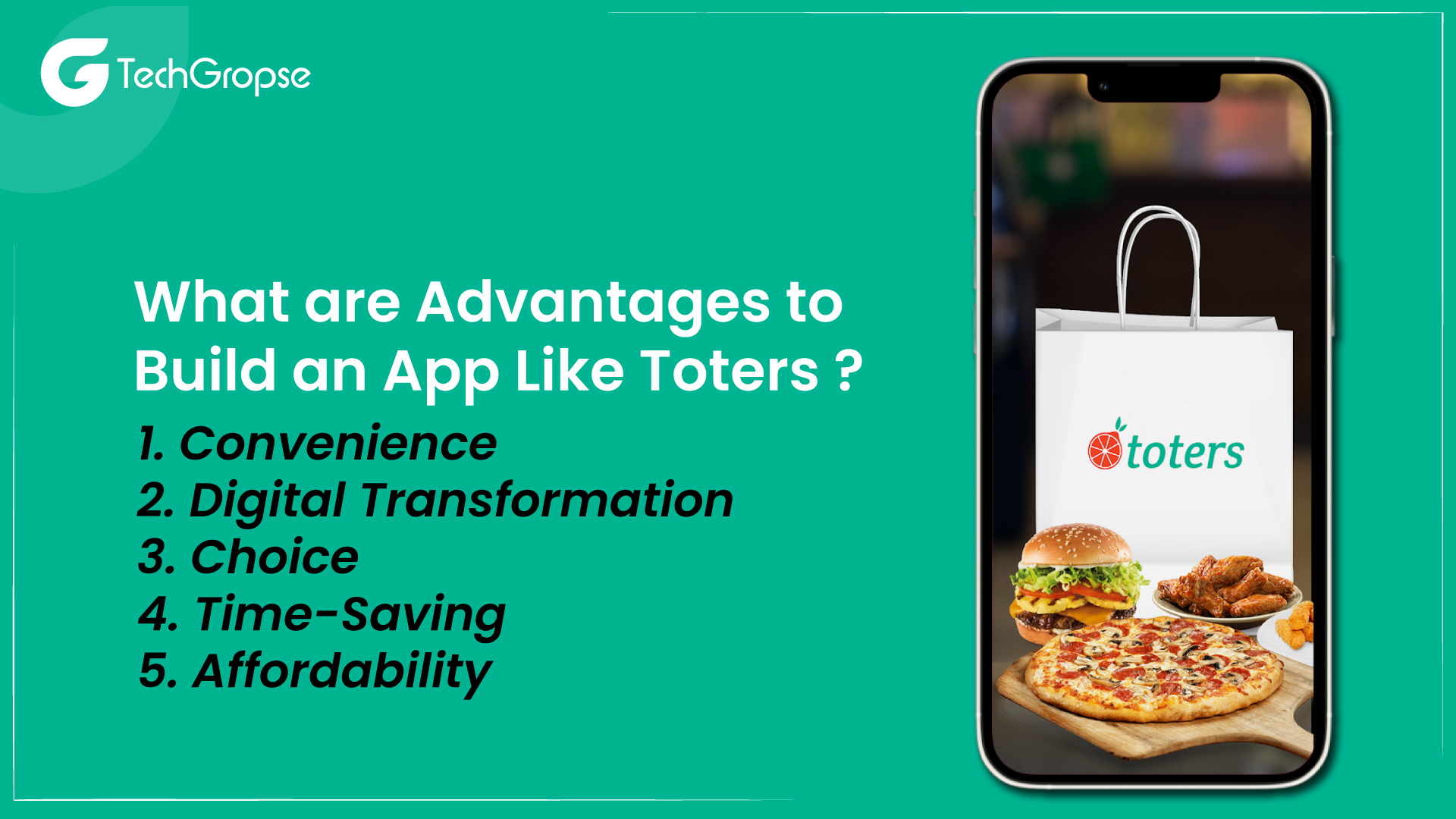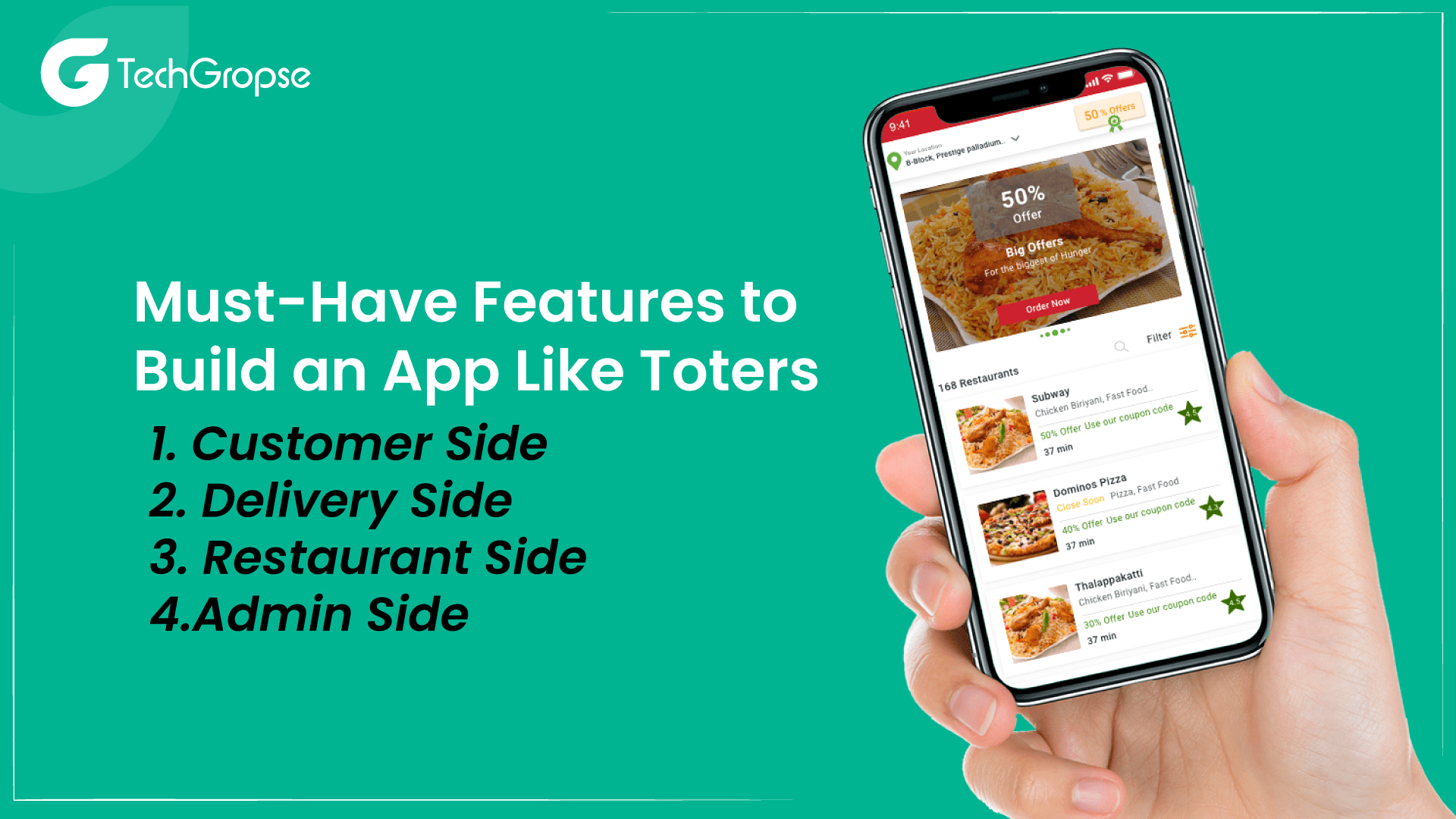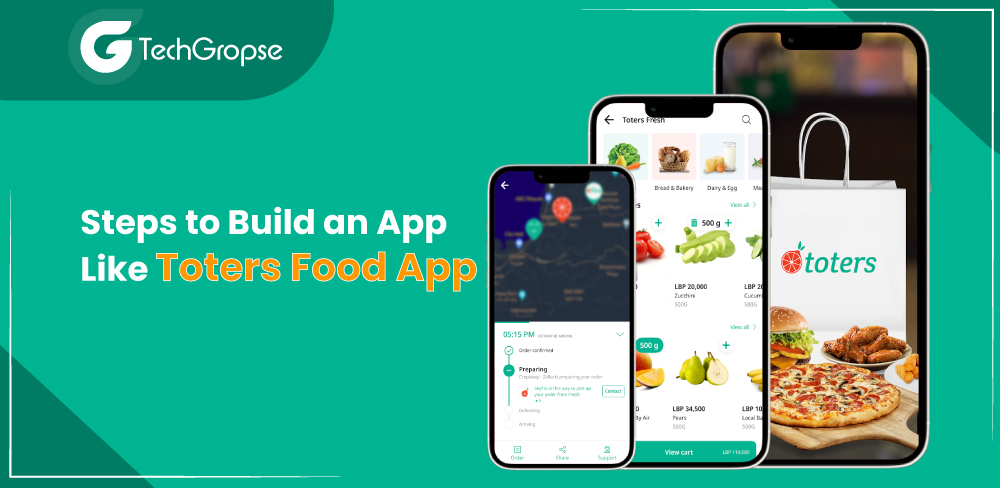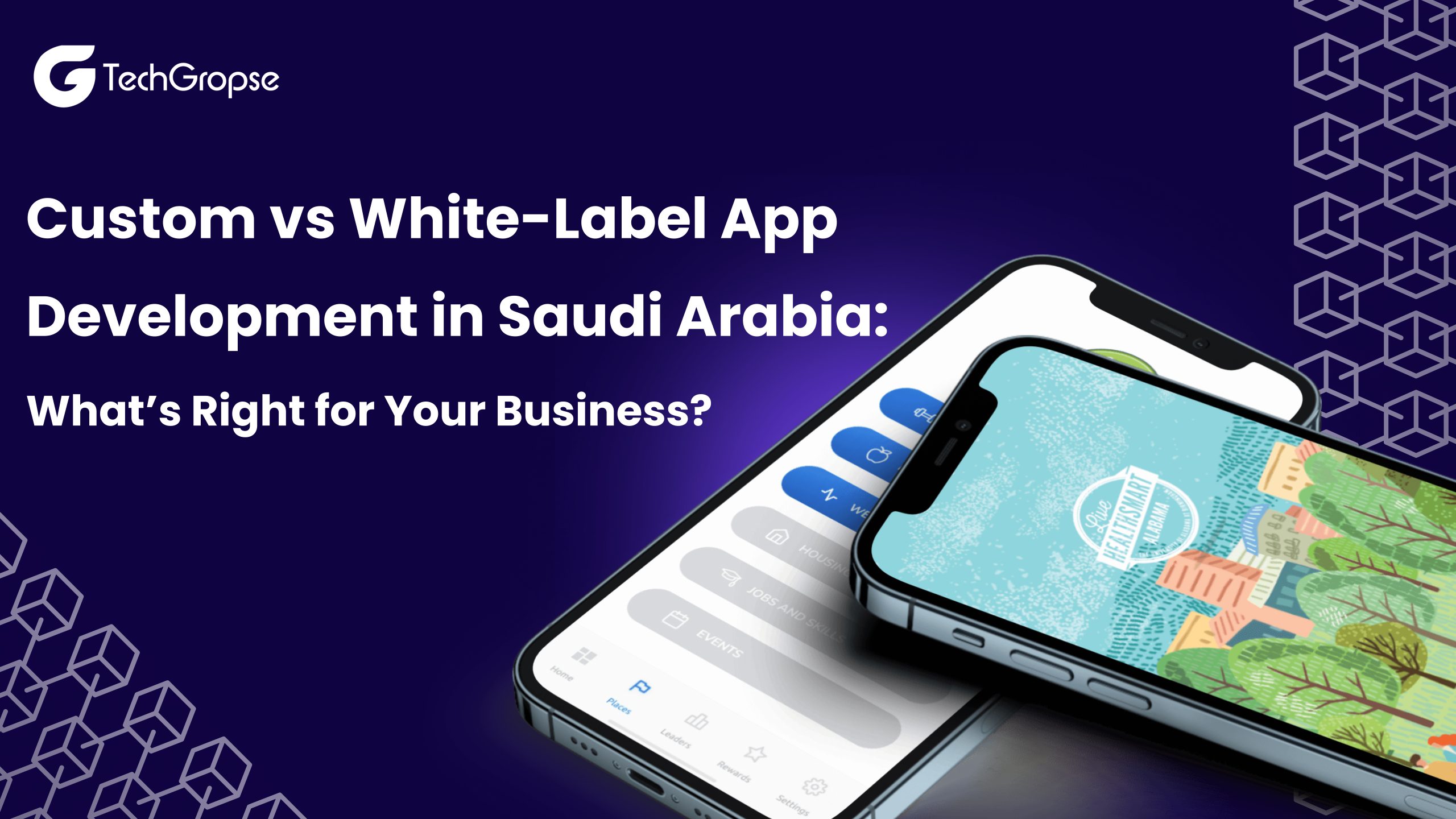Did you know that like, almost half of all restaurant sales now come from ordering food online? It is all thanks to technology and stuff. When you build an app like toters you create a new way of ordering food that has changed the game for traditional restaurants.
People who are super into technology and have really busy lives can now easily order food without even leaving their houses. It is as simple as clicking a button.
This innovative platform provides convenience to users who can place orders with a few taps on their mobile devices, while also offering earning opportunities to delivery personnel.
In this digital age, build an app like Toters is not only about delivering goods but also about delivering convenience, speed, and reliability.
This introduction encapsulates the essence of what an app like Toters aims to achieve – bridging the gap between consumers and delivery services in an increasingly interconnected world.
The Toters food delivery app development company in Saudi Arbia has gained significant popularity in the food delivery market, offering users a convenient and efficient way to order their favorite meals from local restaurants.
With its success as inspiration, this post aims to provide a comprehensive guide on the steps involved to build an app like Toters.
Why Do We See the Boom Of Food Delivery Apps Like Toters?
At its core, an app like Toters is designed to connect users with local delivery drivers and couriers, offering a seamless and efficient way to transport goods from one point to another.
Guess what?
The online food delivery market is growing like crazy. It is predicted to reach a whopping $10,196 million by the end of this year. And get this, by the year 2024, it’s expected to be worth a mind-blowing $14,679 million.
According to USA Today, in 2018, the online food delivery market made a whopping $17 billion in revenue.
And guess what? It went even higher in 2019, reaching a crazy $19.472 billion. In 2021, it’s expected to reach a jaw-dropping $22.332 billion with over 116.1 million people using it.
But wait, there’s more!
In 2023, it is predicted to reach an unbelievable $24.461 billion with over 124.4 million users! That’s a whole lot of people ordering food online!
It seems like the way we eat has totally changed. Instead of going out to eat, more and more people are staying in and ordering food online.
In fact, there has been a rise in developing online food delivery apps in places like Virginia and other parts of the US.
What are Advantages to Build an App Like Toters

Food delivery apps are compelled by a combination of convenience, technology adoption, time-saving benefits, choice, affordability, safety considerations, and the overall transformation of the food industry in response to changing consumer habits and preferences.
You must be aware of these factors before planning to build an app like toters. They have made food delivery apps an essential part of modern dining culture.
1. Convenience
Food delivery apps offer unparalleled convenience. With a few taps on a mobile phone, customers can access a wide variety of cuisines and have their meals delivered to their doorstep. This convenience is particularly appealing in today’s fast-paced world, where time is a precious commodity.
2. Digital Transformation
The proliferation of smartphones and the internet has led to a digital transformation in the food industry. People are comfortable with using technology to meet their daily needs, including food ordering. An app like Toters leverages this trend by providing user-friendly interfaces and seamless payment options.
3. Choice
Food delivery apps offer an extensive range of options. Customers can select from different restaurants, menus, and cuisines, making it easy to satisfy various tastes and preferences. This variety is a significant attraction for users looking for both familiar and exotic dishes.
4. Time-Saving
They eliminate the need to cook or travel to a restaurant, making it especially appealing to busy professionals, students, and families. Additionally, many apps offer features like order tracking, estimated delivery times, and quick reordering, further enhancing efficiency.
5. Affordability
Food delivery apps provide amazing discounts, deals, and loyalty programs that can make dining out more affordable. These promotions incentivize users to order through the app rather than dining in or cooking at home.
6. Safety and Hygiene
Especially in light of the COVID-19 pandemic, food delivery apps have achieved popularity due to their perceived safety and hygiene. Customers can minimize contact with others by having food delivered, reducing the risk of infection.
7. Business Opportunities
The growth of food delivery apps has also created new business opportunities for restaurants and delivery drivers. Restaurants can expand their customer base without the need for additional seating, while delivery drivers can earn income by partnering with these platforms.
How to Build an App Like Toters Food App
If you plan to build an app like Toters it requires careful planning, technical expertise, and a customer-centric approach. Ensure that you listen to your users and adapt your app to their changing needs and preferences.
The food delivery app development company designed the fantastic app to connect customers with delivery drivers and couriers for the transportation of various goods, including food, groceries, and packages.
To create a similar app to Toters, you have to follow these steps:
1. Idea and Conceptualization
- Identify your target market and the specific services you want to offer (e.g., food delivery, grocery delivery, courier services).
- You must understand the requirements of your users.
- Now it’s time to research competitors and analyze their strengths and weaknesses.
- Develop a unique selling proposition that sets your app apart.
2. Market Research and Validation
- Conduct thorough market research to validate the demand for your app
- Collect data on the demographics, preferences, and spending habits of your target audience.
- Seek feedback from potential users through surveys or focus groups.
3. Business Model
- To build an app like Toters define your revenue models like commission fees on transactions, subscription plans, or advertising.
- Make pricing strategies for your services.
- Create a business plan that outlines your financial projections and funding needs.
4. Legal Considerations
- Register your business and get the required licenses.
- Comply with international and local regulations like data protection laws.
- Create terms and conditions, privacy policies, and user agreements for your app.
5. Technology Stack
- Select the right technology stack for food delivery app development. Common options such as Flutter, React Native, or native development for iOS and Android.
- Choose a backend technology for server-side development, such as Node.js, Ruby on Rails, or Python.
Here is a technology stack for food delivery app development presented in a table format:
| Category | Technology/Framework/Tool |
| Frontend Development | |
| Mobile App Development | React Native, Flutter, Kotlin, Swift, Java |
| Web Development | HTML, CSS, JavaScript, React, Angular, Vue.js |
| UI/UX Design | Adobe XD, Sketch, Figma, etc. |
| Backend Development | |
| Server | Node.js, Ruby on Rails, Python (Django or Flask), Java (Spring Boot) |
| Database | PostgreSQL, MySQL, Oracle (RDBMS), MongoDB (NoSQL) |
| APIs and Middleware | RESTful or GraphQL APIs, Middleware for authentication and authorization |
| Authentication/Authorization | OAuth 2.0, JWT |
| Third-Party Integrations | |
| Payment Gateway | Stripe, PayPal, Braintree, etc. |
| Geolocation and Mapping | Google Maps, Mapbox, etc. |
| Push Notifications | Apple Push Notification Service (APNs), Firebase Cloud Messaging, |
| Cloud Services | |
| Hosting and Cloud Storage | Google Cloud Platform (GCP), Microsoft Azure, and AWS |
| DevOps and CI/CD | |
| DevOps Tools | Docker, Kubernetes |
| CI/CD Tools | Jenkins, Travis CI, CircleCI, etc. |
| Security & and Analytics | |
| Security Measures | Encryption (SSL/TLS), Secure coding practices, Security audits |
| Analytics Tools | Google Analytics, Mixpanel, etc. |
| Error Tracking | Sentry, Crashlytics, etc. |
6. Design and User Experience (UX/UI)
- Create a user-friendly and visually appealing app design.
- Develop wireframes and prototypes to plan the app’s layout and functionality.
- Focus on clear call-to-action buttons, easy navigation, and a responsive design for different devices.
7. Development
- Develop the front and back end of the app.
- Implement features such as user registration, profiles, payment processing, order management, and tracking to build an app like toters.
- Integrate third-party APIs for services like mapping and payment gateways.
8. Testing
- Perform extensive testing to ensure the app is bug-free and functions smoothly.
- Test user flows, payment processing, and real-time tracking features.
- Gather user feedback through beta testing.
9. Deployment
- Publish your application on app stores (Google Play Store and Apple App Store).
- Promote your app’s launch through marketing efforts.
10. Marketing and Promotion
- Create a marketing strategy to attract users.
- Use content marketing, influencer partnerships, social media, and paid advertising.
- Offer promotions and discounts to encourage initial usage.
11. Scaling and Continuous Improvement
- Monitor app performance and user feedback.
- Collect data to make informed decisions and updates.
- Consider expanding to new markets or adding new features based on user demand.
12. Customer Support and Maintenance
- Provide customer support channels (e.g., email, chat, or phone) for user inquiries and assistance.
- Regularly update the app to fix bugs, improve security, and add new features.
Must-Have Features to Build an App Like Toters

A food ordering system for the customer side typically includes a range of features to make the ordering process convenient and enjoyable.
Here are some key features you can include to build an app like Toters:
#Customer Side
1. User Registration and Profile Management
- Allow users to create accounts with email or social media login.
- Enable profile management for saving delivery addresses, contact information, and payment methods.
2. Restaurant Listings
- Display a list of various restaurants open for ordering.
- Provide restaurant details, including cuisine type, ratings, and delivery time.
3. Search and Filters
- Implement search functionality to find specific restaurants or dishes.
- Offer filters for cuisine, ratings, distance, and price range.
4. Menu Browsing
- Allow customers to view restaurant menus with item descriptions and prices.
- Include high-quality images of dishes.
5. Add to Cart
- Allow users to add items to their cart for later checkout.
- Show a running total of the order.
6. Order Customization
- Allow customization of dishes (e.g., extra toppings, spice levels).
- Provide options for special requests or dietary restrictions.
7. Checkout and Payment
- Streamline the checkout process with saved payment methods.
- Integrate secure payment gateways for card or online payment.
#Delivery Side
1. Driver Registration and Profile
- Allow drivers to register and create profiles with essential information.
- Verify driver credentials and conduct background checks for security.
2. Order Acceptance/Rejection
- Provide a dashboard to accept or reject incoming delivery orders.
- Offer reasons for rejection, if applicable.
3. Order Details
- Display detailed order information, including items, special instructions, and delivery addresses.
- Include contact details for the customer.
4. Navigation and Maps
- Integrate GPS and navigation tools (e.g., Google Maps) for optimal route planning.
- Provide turn-by-turn directions to the delivery location.
5. Order Pickup Confirmation
- Allow drivers to confirm order pickup at the restaurant.
- Trigger real-time notifications to the customer.
6. Order Tracking
- Enable drivers to track their delivery route and the estimated time of arrival.
- Display order status (picked up, in transit) to both the driver and the customer.
7. Earnings and Payment Tracking
- Provide a summary of earnings and tips earned during a shift or over a specific time frame.
- Enable cashless payments for drivers’ convenience.
8. Delivery History
- Maintain a history of completed deliveries, including order details and earnings.
- Facilitate access to past delivery information.
#Restaurant Side
1. Restaurant Registration and Profile
- Allow restaurants to register and create profiles with essential information.
- Verify restaurant credentials and menu details.
2. Menu Management
- Provide tools to easily manage and update the restaurant’s menu, including adding, editing, and removing dishes.
- Enable customization options and pricing adjustments.
3. Order Management
- Display incoming orders in real-time on a dashboard.
- Allow for order acceptance and preparation confirmation.
4. Accept/Reject Orders
- Provide the ability to accept or reject incoming orders.
- Offer reasons for rejection, if applicable.
5. Order Details
- Display detailed order information, including items, special instructions, and customer contact details.
6. Order Preparation Timer
- Implement a timer for order preparation to ensure timely food delivery.
- Notify staff when the order is ready for pickup by the delivery driver.
7. Integration with POS Systems
- Integrate with the restaurant’s Point of Sale (POS) system for seamless order processing.
- Automatically sync order details to the POS for accurate order tracking.
8. Inventory Management
- Track ingredient and stock levels to prevent overselling unavailable items.
- Send low-stock alerts to the restaurant staff.
9. Order History
- Maintain a history of completed orders, including order details and delivery times.
- Facilitate access to past order information for reference and analysis.
10. Payment Management
- Process payments for orders, including tips, taxes, and delivery fees.
- Offer secure payment gateways for card payments.
#Admin Side
1. User Management
- Admins can manage user accounts such as customers, delivery drivers, and restaurant owners.
- Approve new registrations and handle account-related issues.
2. Dashboard and Analytics
- Provide a dashboard with real-time analytics on orders, revenue, user activity, and restaurant performance.
- Generate detailed reports for business analysis and decision-making.
3. Order Management
- View and manage all orders, including order status updates, cancellations, and refunds.
- Assign orders to available delivery drivers.
4. Restaurant Management
- Admins can approve, onboard, and manage restaurant partners.
- Review and update restaurant information, including menus and operating hours.
5. Driver Management
- Handle driver registrations, verifications, and onboarding.
- Monitor driver activity, earnings, and ratings.
- Assign or reassign drivers to orders as needed.
6. Menu and Inventory Control
- Manage restaurant menus and ensure they are up-to-date.
- Monitor restaurant inventory levels and receive low-stock alerts.
Brief Summary
Certainly, here is a summary of the key features to build an app like Toters for various stakeholders: customers, delivery personnel, restaurants, and the admin panel.
| Feature | Customer Side | Delivery Side | Restaurant Side | Admin Panel |
| User Registration | ✔ | ✔ | ✔ | ✔ |
| User Authentication | ✔ | ✔ | ✔ | ✔ |
| Browse Restaurants | ✔ | ✔ | ✔ | |
| Search and Filters | ✔ | ✔ | ✔ | |
| View Menus and Prices | ✔ | ✔ | ✔ | |
| Place Orders | ✔ | ✔ | ||
| Add to Cart | ✔ | ✔ | ||
| Order Customization | ✔ | ✔ | ||
| Payment Processing | ✔ | ✔ | ||
| Order History | ✔ | ✔ | ✔ | |
| Real-Time Order Tracking | ✔ | ✔ | ✔ | |
| Delivery Confirmation | ✔ | ✔ | ||
| Ratings and Reviews | ✔ | ✔ | ✔ | |
| Push Notifications | ✔ | ✔ | ✔ | |
| Customer Support | ✔ | ✔ | ✔ | |
| Restaurant Registration | ✔ | ✔ | ||
| Menu Management | ✔ | ✔ | ||
| Order Management | ✔ | ✔ | ||
| Accept/Reject Orders | ✔ | ✔ | ||
| Delivery Assignment | ✔ | ✔ | ||
| Driver Tracking | ✔ | ✔ | ||
| Reports and Analytics | ✔ | ✔ | ||
| Admin User Management | ✔ | |||
| Revenue Management | ✔ | |||
| Dashboard and Analytics | ✔ | |||
| Inventory Management | ✔ | |||
| Promotions and Discounts | ✔ | ✔ |
How Much Does it Cost to Build an App Like Toters Food App?
Toters app development cost is challenging because of the wide range of variables involved. However, we can provide you with a rough estimate of cost ranges based on the complexity of the app:
| App Complexity | Cost Range |
| Basic App | $5,000 – $10,000 |
| Intermediate App | $15,000 – $25,000 |
| Advanced App | $50,000 – $100,000+ |
It is crucial to work with an experienced development team or agency to get an accurate cost estimate tailored to your project’s needs. You can consult with a food delivery app development company that can help you define the scope, choose the right technologies, and provide a detailed cost breakdown.
Popular Food Delivery Apps the World Wide
Have a quick look at the list of popular food delivery apps to build an app like Toters:
| Food Delivery App | Country of Origin | Availability | Notable Features |
| Uber Eats | United States | Worldwide | Extensive restaurant network, real-time tracking, and Uber rewards program. |
| DoorDash | United States | United States, Canada | Quick delivery times, group orders, and DashPass subscription. |
| Grubhub | United States | United States | Wide restaurant selection, order tracking, and deals. |
| Postmates | United States | United States | On-demand delivery of various items, including food. |
| Deliveroo | United Kingdom | Europe, Middle East, Asia | Premium restaurant options, Deliveroo Plus subscription, and Editions. |
| Zomato | India | India, UAE, and other countries | Restaurant discovery, ratings, and reviews. |
| Swiggy | India | India | Fast delivery, live order tracking, and Swiggy Super subscription. |
| Foodpanda | Germany | Asia and other regions | Diverse restaurant options, and food deals. |
| Glovo | Spain | Europe, Latin America, Africa | Quick delivery of various products, including food. |
| Talabat | Kuwait | Middle East | Popular in the Middle East with a wide restaurant network. |
Are You Ready to Build an App Like Toters?
Building an app like Toters requires careful planning, diligent research, and a strong development strategy.
By following the outlined steps in this post, you can lay a solid foundation for your own food delivery app and increase your chances of success in a competitive market.
Remember to prioritize user experience, incorporate innovative features, and continuously test and optimize your app to meet the evolving demands of your target audience.
With dedication and the right approach, you can make a standout app that offers seamless food delivery experiences and delights users with its convenience and efficiency.
FAQ: Steps to Build an App Like Toters Food App
1. How much time does it take to build an app like Toters?
The time required to build an app like Toters can vary depending on various factors such as the complexity of the features, the size of the development team, and the availability of resources. On average, it may take several months to a year to develop a fully functional app like Toters, considering the time required for research, design, development, testing, and optimization.
2. What are the essential features that should be included in a food delivery app?
A food delivery app should have features like user registration and login, restaurant listings with menus, a search and filter option, order placement and tracking, secure payment integration, real-time notifications, ratings and reviews, customer support, and a user-friendly interface.
3. How can I differentiate my food delivery app from competitors?
To differentiate your food delivery app from competitors, you can consider implementing unique features or services that set you apart. These could include options like personalized recommendations based on user preferences, loyalty programs, social sharing features, and partnerships with local farms or specialty food providers.










